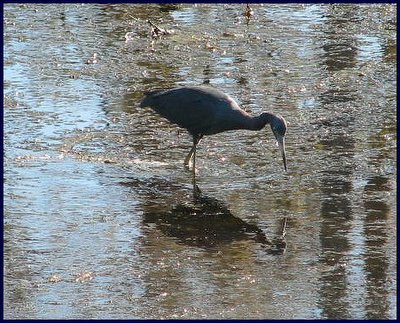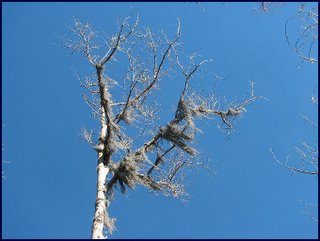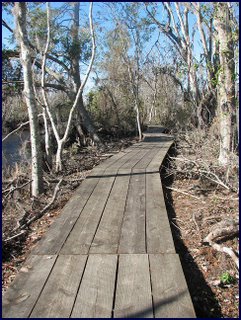




A little blue heron is a fragile bird. Even though it's about two feet high and its wingspan exceeds three feet, its leg and wing bones are so long and spindly that it seems spectrally susceptible to any gust of wind. That long curved heron neck doesn't appear to add anything in terms of solidity.
And yet there they were, survivors of Katrina, mucking about in the canal as if nothing had ever happened.
I spent part of an afternoon during my New Orleans trip at the Barataria Preserve of the Jean Lafitte National Historical Park and Preserve. Monsieur LaFitte was a pirate of some renown, remembered by name in the form of a tiny town and the various components of the Preserve that lie scattered across the Mississippi Delta. I don't know what kinds of natural blasts from water and wind he endured, but as a pirate he's as good a symbol as any for survival in the face of the merciless ravages of weather and politicians.
The park, as you can see, has suffered. The cypress knees huddled together remind me of a childhood book I loved, The Singing River, but the bare limbs from which the Spanish moss waves heroically signal hurricane destruction. It's the south, and the trees have no business looking like the ones at home this time of year.
I walked a mile or so along a path through the swamp, one of the few open to hikers even five months after the storm, and then another mile or so on the boardwalk that parallels an old canal. The yellow-rumped warblers that will find their way back here in May were much in evidence, along with chickadees whose call varies just slightly from that heard in the winter woods of the north. I'm guessing that that means they were Carolina chickadees instead of our own black-capped chickadees.
No alligators, and only the occasional human. I am so grateful for places like this Preserve, where I can be alone with my thoughts and the wide swath of world to which human delight and loss are alike irrelevant.
Down along the canal, a great egret hunted hungrily, and a muskrat so enormous that I at first thought she was a beaver feasted on waterlillies. The little blues were more elusive. In St. Augustine, there are places along the river where you can sit at sunset and watch them sailing in flocks to secret overnight haunts. If there are still flocks of them in southeastern Louisiana, they did not make themselves known to me. But there are solitary survivors, testamentary to the quiet will of nature even in the face of its own most devastating onslaught.















11 comments:
Nature is a lot mre resilient than human beings. I suppose it could be said that, as animals, we are as much a part of nature as any other bird or beast, but we have utterly forgotten our ties to the natural world. We don't see it, don't hear it, don't feel it.
Beautiful post. I've been thinking a lot about the effects Katrina had on wildlife, plantlife, and marine life recently in relation to the extremely mild winter that we're having here in the midwest. The repercussions of mother nature's acts, and of our own conspicuous consumption/global warming have yet to be seen. I fear that some of the aftereffects of Katrina on nature will be felt even longer than the physical ones to man.
Even though it is difficult to see or think about at the time and in the immediate aftermath, many times much good is forthcoming from these catastrophes. Just like how a forest fire can ultimately bring out the best of an area. A time of rejuvenation. Perhaps this is an example of that. We can hope.
Wonderful to see images from Lafitte. One of my favorite sites in the park was the tree size Saw Palmettos. I hope that the salt water intrusion did not wipe them out. Rita took more of a bite out of that area than Katrina. There was quite a lot of storm surge for a week as Rita traversed the Gulf towards So West LA and Tx.
I took a walk into Big Branch Perserve behind my property on Lake Pontchartrain. I was amazed at how the storm surge pushed up the marsh grass into 5 ft. hills as much as 100 ft. into the hardwoods. There was also plenty of downed pine and broken oaks. I didn't feel safe walking the trail to the point until now. Between the hunters and the debris, I had to wait. I'll have photos soon.
My link to my journal decided to go on the blink but I think I have it fixed.
Great pics and thoughful entry. I am glad that the hurricane did not devastate the wildlife population of NO. Your entry made me want to go there and look around. I live 2 1/2 hours away from NO.
I saw your title and was concerned. I was glad that it referred to birds rather than your mood!
Not very long ago, my younger son was fascinated by pirates so I know much of the story of Lafitte. What a character! and yes he probably weathered many storms -- all with no warning too.
Robin - reading these entries is like savoring a good, rich chocolate. I'm sorry not to have found them one at a time as I am gorging on the entries and I'll need to come back to re-read them. You are a gifted writer, thanks for sharing your New Orleans experience with us.
Julia
Information, artful photographs, and gorgeous prose...a rare combination.
Aww, such a writer you are. I imagined myself sharing the preserve.
V
blue heron is my favorite bird, these are wonderful!
This was so beautifully written, Robin, and the pictures seem to capture the esssence of your thoughts at the time they were taken.
Your last sentence about the quiet will of nature wrung quiet chords within me, as I recalled a tiny bird clinging on a branch of a bush outside my lanai when Hurricane Wilma blew through here last September. The palms were practically doubled over, but I watched in amazement as that little bird stood like a steadfast tin soldier hanging tight to its fragile branch.
This was a beautiful series. Thank-you for taking the time to share with us.
Post a Comment